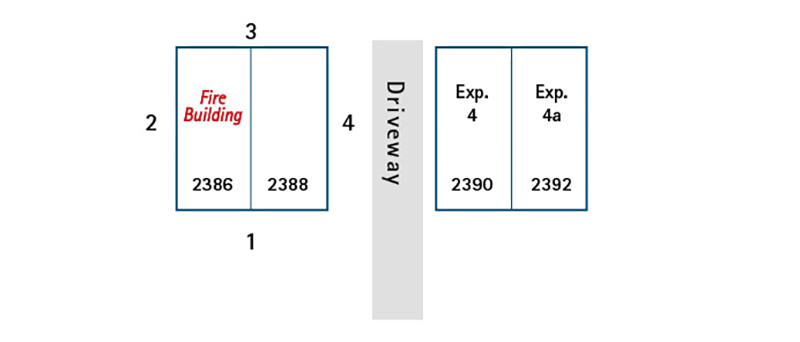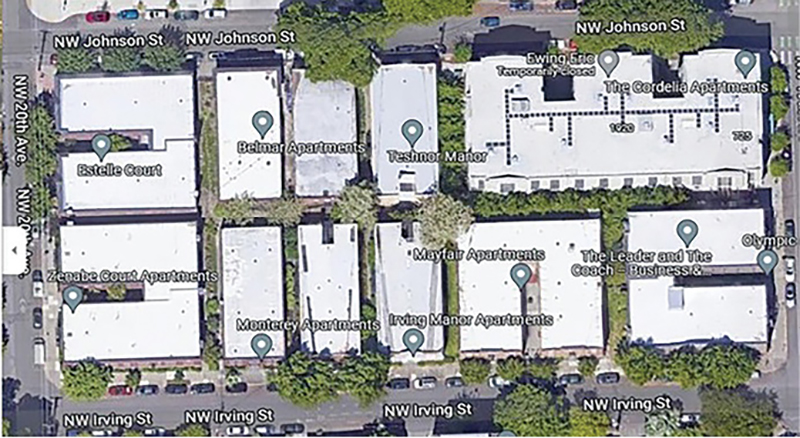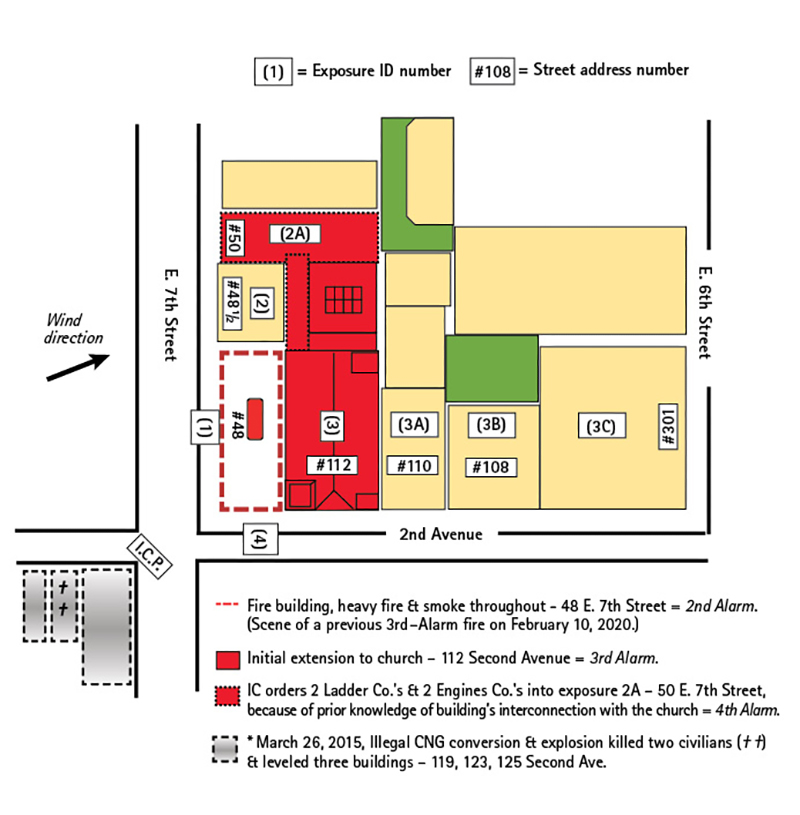By STEPHEN MARSAR
Throughout the United states, exposure identifications vary slightly among different regions. These identifiers usually start with the front or address side of the structure and progress clockwise around the building. The two most common directional indicators used by the fire service today are sides 1, 2, 3, and 4 and sides A, B, C, and D, not both at the same time (Figure 1). These straightforward identifiers have been adopted for decades as directional indicators and location boundaries that make other designations such as North, South, East, and West obsolete.
- Pressler: Exposure Identification
- Interior Exposure Protection: a Neglected Tactic
- Exposure Protection for Well-Involved Structures
- Managing Big Fires 101: Divide and Conquer
Basic Training
The numerical (or alphabetical) exposure identification system can easily be applied to most private dwelling fires and square- or rectangular-shaped structures. However, more complicated buildings such as H-, E-, and O-shaped buildings, commercial strip malls and taxpayers, and large-area warehouses may need to be further divided by sectors or divisions to make specific operations, locations, and communications safer and more efficient.1 Combining the two most common identifiers mentioned above, we will look at large and irregular-shaped buildings and provide considerations that all firefighters, officers, and incident commanders may apply to better coordinate their fire attack strategies and tactics.
According to the United States Fire Administration, a fire exposure is defined as, “A fire resulting from another fire outside a building, structure, or vehicle, or a fire that extends to an outside property from a building, structure, or vehicle.” For example, if a building fire ignites a truck parked outside, the truck fire is an exposure fire. Another example is that of possible exposures, which, according to the Fire Department of New York, is any property within 30 feet of the fire building or fire area.
Strip Malls, Attached Private Dwellings, and Townhouses/Garden Apartments
In each of these occupancy types, we can look at the building as one singular structure and then divided into interior exposures or occupancies. For example, Figure 2 shows a taxpayer/strip mall as a rectangular structure with multiple individual occupancies. Although the clockwise exterior exposures will remain the same (Figure 1), the interior occupancies will need to be further subdivided.
Figure 1. Basic Exposure Identifications

Figures by author.
Figure 2. Basic Taxpayer/Strip Mall Exposure Identification

In addition, we can designate the fire store/occupancy (or original fire area) as “O” and the stores/occupancies to the left and right can be designated as “OB” and “OD.” If more stores are involved, then each can be further subdivided as “OB1,” “OD1,” “OB2,” “OD2,” and so on. Keep in mind that the properties that surround the fire building will keep their designations as exposures B, C, and D.
In the interest of promoting “plain speak” as a national radio standard, it is more commonly understood and communicated that, in a taxpayer/strip mall-type building fire, each specific occupancy can simply be called by its name—i.e., the phone store, the pizza parlor, the bank, and so on—rather than the arguably confusing letter/number designations above (Figure 3).
Figure 3. A Four-Store Taxpayer/Strip Mall with Attached Exposures

For fires in attached private dwellings, townhouses, or garden apartment-type structures, the same rules can apply as in the taxpayer/strip mall above. At a recent line-of-duty death fire in a two-family, attached private dwelling, there was confusion with the original fire building (shown in Figure 4 as house number “2386”) where companies were told of fire in the basement of exposure 4. At first, responding firefighters thought the message was referring to the unattached private dwelling to the right of the fire building on the other side of the driveway (#2390). The message was intended to mean that fire was discovered in the attached residence to the right of the original fire dwelling (#2388). If the entire structure was considered one building and divided into two individual private residences, it may have been better communicated using the “O4” designation or the “attached house on the right” rather than “exposure 4.”
We can address larger buildings that are different from the typical square or rectangle by expanding the exposure identifications. Let’s look at H-, E-, and U-type buildings and the possible designations that can be applied to them (Figure 5).
Figure 4. The Original Fire Building, #2386

Figure 5. Exposure IDs for Buildings with Multiple Wings

Note: With H- and E-shaped buildings, the wings should be designated from left to right or front to rear. If letters are used for the exposure sides, numbers should be used to identify the wings. Conversely, if numbers are used for the exposure sides (1, 2, 3, and 4), then letters should be used for the wings—i.e., A wing, B wing, C wing, D wing, and so on.
The portions of the building connecting the wings can be designated as the “throat”—e.g., “the throat between the A and B wings” or “the throat between wings 1 and 2.” Subsequently, each wing can be further subdivided into the “front,” “middle,” and “rear.” For clarity, “Command, this is Ladder 1, we have fire extension in the middle of the throat between wings 2 and 3, and we need a line” or “Command, this is Ladder 3, we’re starting a trench cut in the middle of the B wing.” The same exposure and wing designations can be applied to U-shaped buildings, with the bottom of the “U” designated as the throat (Figure 6).
In double, triple, or more connected H or back-to-back E structures, the designation of “wings” and “throats” would just keep expanding sequentially according to the alphabet or numerical designations (Figure 7).
Figure 6. Throat Designations for U-Shaped Buildings

Figure 7. Building Exposures for Multiple-Winged Buildings

Irregular Shapes
Irregular-shaped buildings pose additional areas for consideration. Let’s look at a basic L-shaped structure and a few possible exposure identification strategies that could be applied (Figure 8). The identity of the irregular-shaped building exposures will, of course, be dependent on many factors such as the location of the command post, parked vehicles, the landscape, windows, fire escapes, and the building entrances.
Figure 8. Exposure IDs for L-Shaped Buildings

Option A: The simplest and least complicated example is where exposures A and C make up the entire structure. In this case, however, it may be better to just use the terms “front” and “rear.” This option may work particularly well if the two short sides of the structure do not contain windows or fire escapes.
Option B: A more complicated approach may be necessary if each side of the building contains windows or fire escapes.
Option C: This is the most complicated, where we identify each of the six sides of the structure following the basic clockwise application.
Note that any wall that contains windows or fire escapes will require its own exposure identification, so tasks such as laddering, vent-enter-isolate-search, and rope rescues can be accomplished quickly and without confusion.
To put what you’ve learned into practice, look at photos 1 and 2 and decide how you would label the exposures of each of the buildings shown and how you would report them on the radio if you were standing at the command post in front. An example to follow would be from the six-alarm Middle Collegiate Church conflagration in New York City on December 5, 2020, with exposure designations 1, 2, 3, and 4, where I was the IC (Figure 9).2

(1) An L-shaped townhouse. (Photos courtesy of Google Maps.)

(2) One block with several different shaped buildings and exposures.
Figure 9. Conflagration with Multiple Exposures

Large Retail Complexes
An ever-increasing concern we’re seeing across the country is the closing and, in some cases, abandonment of large, enclosed mall structures and big-box warehouse facilities. In these cases, the basic exterior exposure numbering/lettering systems described above can certainly be applied. However, because of their sheer size, expansive interior layouts, and exterior footprints, we will probably be better served using the names of the stores (or, at least, the locations of these former “anchor stores”) that are involved or close to the main fire location.
Where the store name signs have been removed, it would be wise for that district’s fire department to designate each entrance by a number or letter and divide the entire complex into smaller areas that would be served by each of those designated entrances. In some municipalities, this may require the approval and cooperation of local, state, city, town, or county building departments, depending on local code or law.
Regardless of whether your department uses numbers or letters to designate exposures, you will now be able to apply them to larger and odd-shaped buildings within your company’s or department’s response area. Both systems work as long as everyone on the fireground is on the same page. The errors and confusion resulting from miscommunication can have devastating effects on the incident because of delays in deploying or redeploying resources, apparatus, and equipment. Ongoing company and departmentwide training is essential to learn and keep these exposure identification skill sets sharp.
References
1. Pressler, B. “Exposure Identification.” Fire Engineering, May 1996.
2. Marsar, S. “Six-Alarm Fire at Historic Church.” Fire Engineering, July 2021.
STEPHEN MARSAR, MA, EFO, CIC, is a 37-year emergency services veteran and a battalion chief for the Fire Department of New York. He is a former chief and commissioner of the Bellmore (NY) Volunteer Fire Department, an FDNY Type 1 IMT unit leader, a national fire instructor I and II, a New York State EMS regional faculty member, and a Nassau (NY) Community College adjunct professor. Marsar has a master’s degree in homeland defense and security from the Naval Postgraduate School and a bachelor’s degree in fire science and emergency services administration from SUNY—Empire State College. He is also a two-time winner of the FEMA/USFA National Outstanding Research Award. Marsar travels throughout the United States and abroad as a speaker and is an advisory board member of Fire Engineering and FDIC International.

